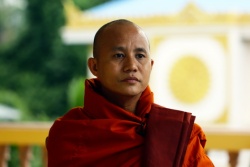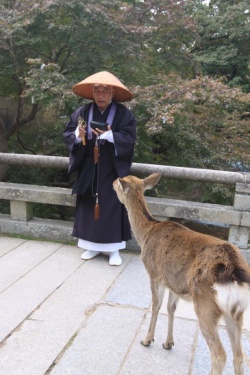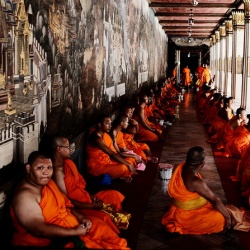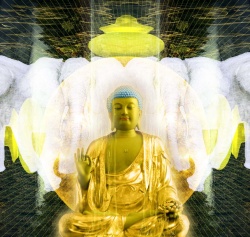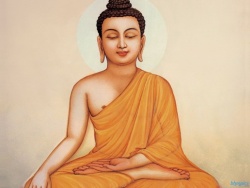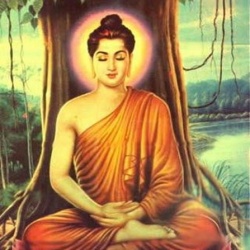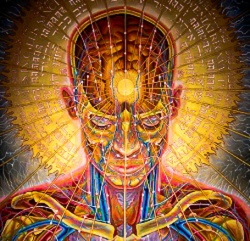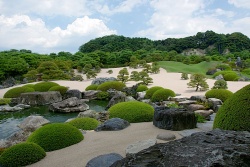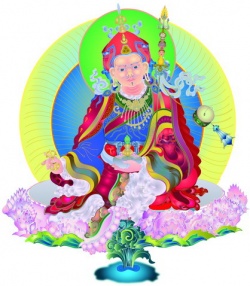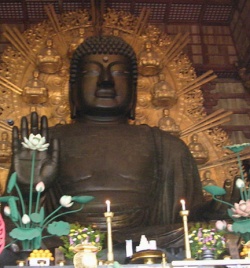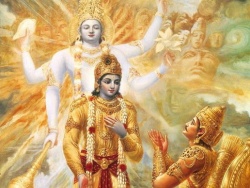Agni The Hindu God of Fire
In early Hinduism, Agni is one of the most important of the Vedic gods.
Agni is the god of fire, and much of his importance comes from the role of fire in sacrifices and Hindu rituals.
Agni is the embodiment of the fire which consumes the offerings to the Hindu gods, so he is seen as the mediator between heaven and earth.
Agni was so important to the ancient Indians that 200 hymns in the Rig Veda are addressed to him, and eight of its ten books begin with praises dedicated to Agni the Fire God.
To honor Agni, Hindus are expected to face fires in the proper direction for different purposes.
When facing East, the fire should be used for sacrifices to the gods;
when facing South, the fire should be used for sacrifices to the spirits of the dead.
Fires should face west when used for cooking.
As Hinduism evolved over the centuries and the emphasis became less on performing sacrifices and more focused on devotion, Agni’s status fell off dramatically. He became an incarnation of either the Hindu Gods Shiva or Brahma.
Eventually Agni has come only to be called on by lovers.
But Agni still has a role in the worship of other Hindu gods and goddesses.
The sacrificial fire used in Hindu rituals is seen as an incarnation of Agni, so he serves as a conduit that “carries” the sacrifice of a worshiper to the gods or goddesses that are being worshiped.
He is the burning ghee (clarified butter) that is used in devotional offerings.
The god Agni is also seen in ring of fire that surrounds the Dancing Shiva Statues found in Hindu temples.
He is also thought to exist as the fire in the soul of all of us, and is the heat energy that lights the stars and the sun.
Hendon Harris says:
Why is the whole world so slow to realize the connection between the ancient Anasazi (Puebloan) people of North America and their knowledge and use of Vedic religious customs, customs and deities.
These are still being used by the Puebloan people living there today.
The most obvious example is the Vedic Saptapadi (Seven Step Seven Vow Wedding Ceremony from India) used by Native American tribes as the most common wedding among these tribes of North America.
Their ceremony is walked clockwise around a sacred flame.
This fireceremony is identical to the Vedic fire ceremony used to worship Agni.
But what about the Anasazi?
They disappeared from North America around 1300 CE. However, the ruins of where they once lived are still extant.
What is noteworthy about these ruins is that the biggest rooms belonging to the Anasazi were ceremonial rooms called Kivas.
These rooms all have very large fire pits in them.
Some of the ruins have been determined to have burned down to the stones themselves because of the large fires in the pits burning out of control at some time and bringing the building down.
An interesting thing about these kiva fire pits is that they look identical to the homa (havan) fire pits used by Tibetan Buddhists to this day to worship Agni.
Were the Anasazi worshiping Agni?
I believe they were and here’s why.
The Manji (swastika) is still used in that area.
Although Eurocentric scholars claim there is no connection between the North American manji and the Vedic manji then why do the Navajo tribesmen refer to this symbol as “the whirling logs” and the Hopi people refer to it as “the whirlwind”.
The literal interpretation of the Sanskrit word Manji into English is “Whirlwind”.
What are the odds of that being a coincidence? None!
Or what about the Vedic phallic symbols that are found throughout the area. Google:
“Kokopelli and Fertility Symbols”
“Buck and Mabel’s King Kong Dong” and
“Wahweap Hoodoos by Tanya”.
In the Images section of the last one you will see a two toned image in incredible detail I believe in the second row.
Nobody can claim that the Torana originated anywhere else but India and that it is a significant Vedic Buddhist symbol.
Then why do the Navajo worship at Rainbow Bridge?
Google:
“Rainbow Bridge Hendon Harris” “Delicate Arch, Utah”, “Anasazi Arch, New Mexico”, “Tour of the Big 16” and “Window Rock Navajo Capital City.
This is just a few of the clues. There are countless others and more are being researched for future release.
Goggle:
“Were the Anasazi People Buddhists?”, Mandalas, Mantras, Manjis and Monuments”, “Dimensions of Dine and Buddhist Traditions” and “Buddhist Symbols, Customs and Monuments North America.”.
Although Eurocentric scholars seem to be more interested in analyzing shards of broken pottery from these Anasazi sites, the facts apparent on the ground declare the obvious ancient Vedic Buddhist connection here in the Four Corners region.
Hwui Shan gave a report (recorded in the Liang Shu) to the Chinese Emperor in 502CE that he had traveled to a place long known in China as Fu Sang and successfully converted the natives there to Buddhism and that in doing so he had changed their culture.
We now find those symbols in North America. Does anyone want to speculate as to where Fu Sang might be?
The October edition of the Smithsonian Magazine carries an article “Did Marco Polo Discover America?” 200 years before Columbus on the western side or the side closest to China.
Remember that Marco Polo, his father and his uncle came overland to China.
Where did Marco get the ship to travel on the ocean to N America?
Does it take a leap of logic to believe that it was most likely an Asian ship with and Asian crew guided by Asian navigation?
I don’t think so. Given the similarities of the maps and descriptions of the countries along the way Polo’s trip sounds incredibly like the trip taken 800 years earlier also to a place that the Chinese had known for centuries as Fu Sang.by a Buddhist missionary cleric known as Hwui Shan.
Is it a mere coincidence that the North Pacific Gyre flows exactly this same way enabling anyone who takes this current to Fu Sang (N America) to visit with the people and the countries that are located on the coasts of the ocean where the North Pacific Gyre flows past.
Renown Sinologist ([[[Joseph Needham]]] has report that this current has been known since ancient times by the Chinese as the Wei Lu current.
Google: “Fu Sang Charles Leland Index” for a detailed explanation written in 1781 by Colonel Barclay Kennon of the U S Expeditionary Service 1853-1856 on how easy this trip is to travel.
(When you get to the index click on Chapter VII and then read Chapter VII and Chapter VIII)
It appears easy for the west to see trips made by Europeans to N America.
However, when it comes to Asians doing the same thing regardless of the evidence on the ground and the numerous written reports that state this happened the west is quick to deny this was possible.
Google: “Pale Ink Henriette Mertz Chapter II” and “Evidence of Vajrayana Buddhism in Pre Columbian North America”
You can only keep a lid on the truth for so long before the power of truth causes it to be known and ultimately acknowledged.
Chattras show up all over the North American Pacific South West.
Google:
“Snake Dancers Rock Walpi Village”, : ”Bent Hoodoo by Ned”, “The Cobra, Moab”, “Mushroom Rocks State Park, Kansas”, “Mexican Hat Rock” and “Balanced Rock Devil’s Lake Wisconsin” for just a few in America.
For an identical image in ancient Buddhist Thailand google: “Isan Home of Ancient Dvaravati Ruins”.
For images of rock carved huge Toranas google;
“Delicate Arch,
Utah”,
“Anasazi Arch”,
“Corona Arch”,
“Rainbow Bridge” and
“Tour of the Big 16”.
If you ever doubt that ancient Vedic Buddhist (Vajrayana= Tibetan) rock carvers could do projects this large just consider the “Ellora Caves, India” and the “Giant Carved Buddhas of Gandhara (Afghanistan).
Google: “Buddhist Customs, Symbols and Monuments North America”.
If this is true why isn’t it known and widely accepted?
Because it would clearly demonstrate that Europeans were not the first foreign culture to bring cultural and religious influences here to the Americas.
This evidence is clearly visible and recognizable to those who know Buddhist symbols and customs.
The wide acceptance of this evidence would change world history.
It would open up the discovery of the travels of ancient Buddhist missionaries not only to North America but also in Africa and not only Southern Europe but Northern Europe as well.
The best clue on where these ancient Buddhists clerics traveled is to google all the sites you can on amazing examples of Balanced Rocks. Google “Incredible Balanced Rocks Worldwide”.
I can’t tell you why because I don’t know but I do know these talented Buddhist missionaries LOVED TO CARVE ROCK. \\And they were not only good at carving the rock.
They were also fabulous at balancing rock. This skill took incredible engineering skills.
For examples of these formations worldwide google:
“The Golden Rock Pagoda Myanmar”,
“The Devil’s Marbles Australia”,
“Krishna’s Butterball, India”,
“The Costa Rica Petrospheres”,
“Balanced Rock, Tuba City Arizona”‘,
“The Sphere Knockan Crag Scotland”,
“Bubble Rock Acadia Park Maine”,
“Balanced Rock Omak Lake Washington” and
“Wat Phra That Hin Kio Doi Din Ki,
Thailand for just a very few of the examples of their work using their rock carving and balancing skills for “shock and awe” religious purposes.
It still impresses to this very day thousands of years later.
If you are thinking this is a stretch of logic I have an example for you to consider about the West’s ability to surppress information.
Flourishing Hellenistic (Greek) Buddhism in Greece before the Christian era is widely accepted. Nobody disputes it.
It was a significant part of ancient Greek culture.
You can google information on this.
Then why is it that NOBOBY wants to acknowledge the cultural and religious origins of the Meteora Monasteries in Greece.
They are now occupied by Christian monks who love their new homes. The Christian monks don’t and never have laid claim to having originally built them.
They found these monasteries vacant hundreds of years ago and moved in. But everyone says it’s a mystery who it was that originally built these monasteries.
Give me a break! Anyone who takes a few minutes to look at these Meteora images recognizes the Buddhist Asian influences in this style of architecture.
There are literally scores of monasteries throughout Asia that are built on the tops of mountains in this same style using the same techniques.
When did westerners ever build ancient monasteries like this?.
Why hasn’t anyone ever even suggested that Buddhists were the probable originators of these Meteora Monasteries?
There is another “discovered empty ancient monastery” in eastern Spain.
Google: “Montserrat Monasteries Spain” Montserrat means “cut mountain” in Spanish.
Who have we already established as a religious group that loved to cut rock– Ancient Buddhists.
Today Montserrat is also the happy home for Christian monks who have never claimed to have built the place.
They also found it empty and moved in a long time ago.
I believe there is evidence of ancient Buddhist influences all around the world.for those willing to connect the dots.
If it wasn’t the Buddhists who clearly had the skills and desires to do this in Asia then who
